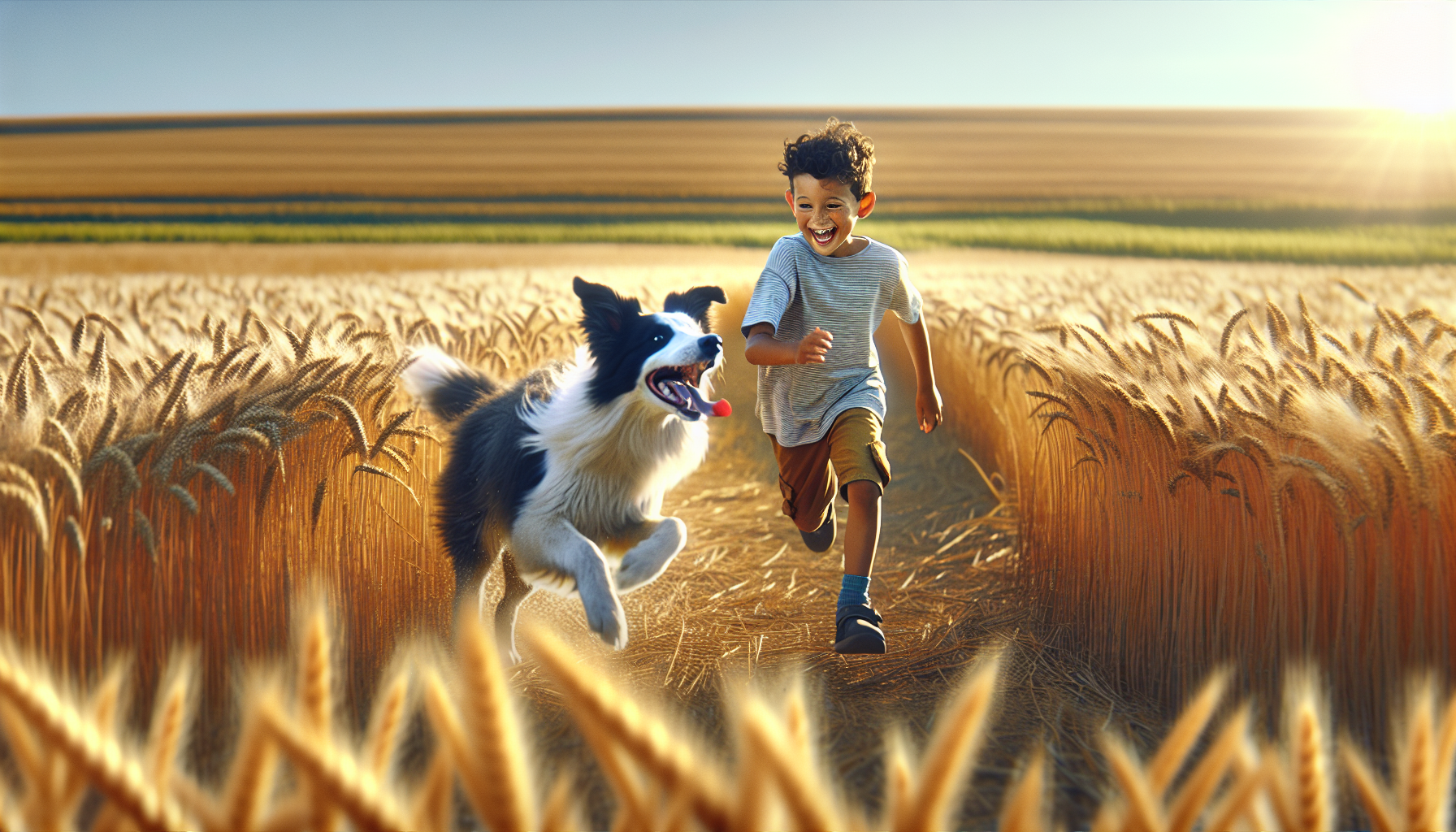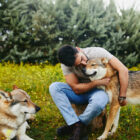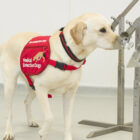How Human-like Are Dogs?

When we think about dogs, it’s natural to wonder how human-like they are. After all, our canine companions have been by our side for thousands of years, serving as loyal friends, working partners, and beloved family members. But just how similar are dogs to humans? To answer this question, let’s start with the basics.
Cognitive Similarities between Dogs and Humans
When it comes to cognitive abilities, dogs have consistently demonstrated impressive similarities with humans. One area where this is particularly evident is in problem-solving skills.
Studies have shown that dogs are capable of learning through observation, a process known as social learning. This means they can pick up new behaviors by watching us perform tasks or actions. For example, researchers have taught dogs to retrieve objects using simple commands and rewards. When the dog sees its owner performing this task, it will often learn the behavior itself.
This ability is not limited to simple tasks; dogs have also been observed learning complex problem-solving strategies through observation. In one study, a dog was shown how to open a puzzle feeder by watching its owner do so. The dog then used this knowledge to solve similar puzzles on its own.
Dogs Are Self-aware
Dogs’ cognitive abilities are further demonstrated in their impressive memory and learning capacities. Research has shown that dogs can remember complex routines and tasks after just a few repetitions. This is likely due to the strong bond between humans and dogs, which encourages social bonding and reinforces learned behaviors.
Another area where dogs show remarkable human-like qualities is self-awareness. Researchers conducted an experiment in which dogs were placed in front of mirrors. Initially, many dogs displayed confusion or even aggression towards their reflections. However, after repeated exposure to the mirror, most dogs began to recognize themselves and use the reflection as a tool for exploring their own bodies.
This self-awareness is typically associated with primates and dolphins, but dogs have been observed displaying it too. This cognitive ability likely arises from the strong social bond between humans and dogs, which encourages self-reflection and exploration of one’s surroundings.
Dogs Are Creative Problem-Solvers
The canine brain also contains regions involved in decision-making processes similar to those found in humans. The caudate nucleus, a region responsible for motor planning and learning, is particularly well-developed in dogs. This suggests that dogs may be capable of making complex decisions based on learned behaviors and environmental cues.
In addition to these cognitive abilities, dogs have also been observed exhibiting creative problem-solving skills. In one study, researchers presented dogs with a puzzle feeder containing treats. The dog was initially unable to access the treats but eventually used its creativity to figure out how to open the feeder by using tools (such as sticks) and exploiting environmental features.
Dogs Have Emotional Intelligence Like Humans
Emotions play a significant role in human relationships, and dogs are no exception. They exhibit emotions like joy, fear, anxiety, and even empathy towards their human companions.
One area where this is particularly evident is in the way dogs respond to human emotional states. Studies have shown that dogs can recognize and respond to human emotional cues, such as tone of voice, facial expressions, and body language. For example, a dog may sense when its owner is upset or stressed and provide comfort by nuzzling or licking their hand.
This ability to read human emotions is likely due to the strong social bond between humans and dogs. Dogs have evolved to live alongside humans for thousands of years, which has led to the development of complex emotional intelligence.
The Emotional Lives of Dogs
In addition to recognizing human emotions, dogs also exhibit a range of emotional states themselves. For example, they can experience joy when playing or receiving attention from their owners, fear in response to loud noises or unfamiliar environments, and anxiety when separated from their pack (or family).
Dogs’ emotional lives are further demonstrated by their ability to form close bonds with humans. This is often referred to as “attachment” – a deep sense of connection that drives dogs to seek out human interaction and comfort.
Research has shown that this attachment can have significant benefits for both humans and dogs. For example, studies have found that children who grow up in households with dogs tend to develop better social skills and emotional intelligence than those without canine companions.
Furthermore, the emotional bond between humans and dogs can also have therapeutic benefits. Therapy dogs are trained to provide comfort and support to individuals with mental health conditions or disabilities. These dogs often exhibit high levels of empathy and understanding towards their human clients, which can lead to significant improvements in mood and well-being.
Dogs Are Jealous
Jealousy is a complex emotion that can be observed in many species, including dogs. While it may seem surprising to consider canine jealousy, research has shown that dogs do indeed experience jealousy.
One study published in the journal Animal Behaviour found that dogs exhibit jealous behavior when their owners interact with other animals or objects. In the experiment, researchers placed a dog and its owner in a room with another animal (either a stuffed animal or a real one). T
The owner then spent time interacting with the other animal, which caused the dog to display signs of jealousy. These signs included growling, snapping, showing aggression towards the other animal and trying to interrupt the interaction between the owner and the other animal.
The study’s findings suggest that dogs are capable of experiencing jealous emotions when they feel their bond with their owners is being threatened. This can be especially true in situations where the dog feels like it’s not getting enough attention or affection from its owner.
Real-life examples of canine jealousy abound. A family may notice that their dog becomes agitated and protective when a new pet enters the household; a dog may become jealous if its owner spends too much time playing with another animal, such as a child’s stuffed toy; some dogs have even been known to exhibit jealous behavior towards inanimate objects, like toys or treats.
Depression in Dogs and Humans
Mental health is a pressing concern for both humans and animals alike. Depression, in particular, has been recognized as a significant issue affecting millions worldwide. While it’s often associated with human experience, depression can also affect dogs.
Research suggests that dogs are capable of experiencing depressive-like symptoms when they’re subjected to chronic stress, social isolation, or changes in their environment. These factors can lead to behavioral changes such as withdrawal from activities and interactions, changes in appetite and sleep patterns and increased anxiety and fear responses.
Just like humans, depressed dogs may exhibit a range of physical symptoms: weight loss or gain, lack of grooming habits, decreased energy levels and increased shedding.
The connection between canine depression and human depression is more than just anecdotal. Studies have shown that the emotional bond between humans and their pets can be bidirectional, meaning that the mental health of one species can impact the other.
A study published in the Journal of Clinical Psychology found that pet owners who experienced depression were more likely to report symptoms of anxiety and stress when they didn’t have access to their pets. Another study discovered that dogs whose owners suffered from depression exhibited increased levels of cortisol, a hormone associated with stress.
The parallels between canine and human depression are striking. Both species can experience changes in appetite and sleep patterns, increased anxiety and fear responses and withdrawal from activities and interactions.
While the symptoms may be similar, it’s essential to recognize that dogs require different approaches when addressing depressive-like behaviors. Canine therapists use a range of techniques including positive reinforcement training, environmental enrichment and socialization with other animals and humans.
Human and Dog Communication
Communication is a vital aspect of human-canine relationships, and dogs have evolved to develop unique methods for conveying information.
One way dogs communicate with humans is through vocalizations – barks, whines, growls, and other sounds that convey emotions and intentions. For example, a dog may bark loudly when it sees an intruder or hears a strange noise, while a high-pitched whine might indicate excitement or anxiety. Humans can pick up on these cues by paying attention to the tone, volume, and context of their canine companion’s vocalizations.
Body language is another essential aspect of canine communication. Dogs use postures, facial expressions, and tail positions to convey emotions like happiness (wagging tail), fear (tucked tail), or aggression (stiff posture). Humans can read these cues by observing the dog’s overall demeanor and responding accordingly.
In addition to vocalizations and body language, dogs also communicate through scent marking. They use their sense of smell to detect pheromones – chemical signals that convey information about an individual’s reproductive status, dominance hierarchy, or emotional state. Dogs may rub their faces on surfaces, lift their legs to mark territories, or sniff out hidden scents to gather this type of information.
Physical Contact
Canine communication is not limited to these methods alone; dogs also use touch and physical contact to interact with humans. They may nuzzle hands, lick faces, or even give gentle bites (like a human might do) as a way to initiate play or show affection. Humans can respond by petting the dog, giving treats, or engaging in playful activities.
In real-life scenarios, effective communication between dogs and humans is crucial for building trust, resolving conflicts, and strengthening bonds. For instance, a service dog may use vocalizations and body language to alert its handler about potential hazards or changes in their environment. A therapy dog might employ gentle nuzzling and soft whines to comfort a patient with anxiety or PTSD, while a family pet may use playful barks and energetic playfulness to initiate interaction with children.
By recognizing the various ways dogs communicate, humans can improve relationships by responding appropriately to these cues. This mutual understanding fosters empathy, trust, and cooperation – essential components of any successful human-canine partnership.
How Dogs Became So Human-like
The evolution of dogs from wolves is a remarkable story that has shaped their behavior, physiology, and cognitive abilities.
Around 15,000 to 30,000 years ago, humans began domesticating gray wolves (Canis lupus) in various parts of the world. This process was likely driven by the need for companionship, protection, and hunting assistance. Over time, these early dogs adapted to their new environments and developed unique characteristics that distinguished them from their wild ancestors.

The Results of Breeding
One key aspect of dog evolution is their ability to thrive in a wide range of habitats and climates. Dogs have been bred for various purposes – such as herding, guarding, or companionship – which has led to the development of diverse breeds with distinct physical and behavioral traits.
In terms of cognitive abilities, dogs have evolved to excel at reading human emotions and behaviors. Studies have shown that dogs can recognize and respond to human emotional cues, such as tone of voice, facial expressions, and body language. This ability is thought to be an adaptation for living alongside humans, allowing dogs to better navigate their social environments.
The evolution of dog cognition has also been influenced by their unique relationship with humans. Dogs have learned to rely on humans for food, shelter, and protection, which has led to the development of complex problem-solving skills and memory abilities.
In addition to cognitive adaptations, dogs have undergone significant physiological changes as a result of domestication. Their diet has shifted from primarily meat-based to include more plant matter, they have developed smaller body sizes compared to wolves, and their coat colors and textures have changed in response to environmental pressures.
Real-life examples of dog evolution can be seen in the way different breeds have adapted to specific environments or tasks. Herding dogs like Border Collies and Australian Shepherds have evolved for their ability to work with livestock, using keen eyesight and agility. Guard dogs, on the other hand, like German Shepherds and Rottweilers, have developed strong protective instincts and physical strength.










